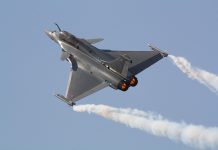
Russia has initiated an extensive program to modernize its Tu-160M “White Swan” strategic bomber while concurrently developing a next-generation bomber, demonstrating a clear focus on enhancing its long-range strike capabilities. This dual approach reflects Moscow’s strategic intent to maintain leadership in military aviation and ensure its aerospace sector remains at the forefront of innovation.
The Tu-160M’s modernization is not merely about maintaining relevance but represents a comprehensive overhaul designed to redefine its operational role in contemporary warfare. With advanced avionics, state-of-the-art weaponry, and upgraded propulsion systems, the bomber is poised to achieve superior performance in long-range operations. Notably, it includes enhanced electronic warfare (EW) capabilities, precision-strike systems, and improved survivability against modern air defense threats.
Reviving production of the Tu-160M required re-establishing complex manufacturing techniques, such as vacuum welding of titanium—an advanced process that remains cutting-edge. Additionally, production lines for critical structural components, including those enabling supersonic speeds and extended range, were reactivated to support this effort.
While the Tu-160M’s upgrade marks a significant milestone, Russia’s aerospace ambitions extend further. Work is already underway on a new strategic bomber platform, shrouded in secrecy but expected to feature cutting-edge stealth technologies, AI-driven avionics, and versatile payload configurations. This new aircraft aims to surpass current capabilities and ensure Russian airpower remains competitive for decades.
To support these endeavors, Russia is investing heavily in its production and testing infrastructure. Manufacturing facilities are being modernized with advanced equipment, and testing grounds are receiving substantial investments to accommodate new technologies. These upgrades underscore Russia’s commitment to advancing its military aviation capabilities and preparing for the challenges of future warfare.
The Tu-160M, a symbol of Russia’s strategic air dominance, is undergoing a transformation to remain a formidable force in both conventional and nuclear roles. At the same time, the development of a new bomber signals Russia’s forward-looking vision to maintain its place as a global leader in air power amidst evolving military dynamics.
As global tensions rise, Russia’s strategic aviation projects—ranging from the Tu-160M to next-generation bombers—underscore the country’s intent to shape future battlefields. These initiatives demonstrate a clear commitment to ensuring that strategic aviation remains a cornerstone of Russia’s military doctrine for the foreseeable future.
The Tu-160M, the world’s largest supersonic bomber, is central to Russia’s strategic deterrence. The modernized version boasts advanced avionics, upgraded weapon systems, and enhanced survivability, making it a potent asset for modern combat. The bomber features a fully digital cockpit with multifunction displays to improve pilot situational awareness, and new navigation systems integrate GLONASS with inertial guidance for precise operations in GPS-denied environments.
The upgraded radar, likely an NV-70M, enhances target detection capabilities and provides terrain-following functionality for low-altitude flight. The Tu-160M’s weapon systems have been enhanced to carry a broader range of modern munitions, including the long-range Kh-101 and Kh-102 cruise missiles, capable of striking targets over 3,000 miles away, as well as conventional munitions like high-explosive and penetrating bombs.
Equipped with NK-32-02 engines, the Tu-160M is capable of supersonic speeds up to Mach 2 and has an operational range exceeding 7,500 miles, aided by in-flight refueling. The aircraft’s EW systems, including radar warning receivers, jamming pods, and countermeasures, significantly enhance its ability to penetrate sophisticated air defenses and avoid interception.
The structural upgrades prioritize both durability and performance, using advanced materials like titanium and composites to reduce weight without compromising strength. The aircraft’s variable-sweep wing design optimizes aerodynamics for various flight profiles, from subsonic to supersonic speeds.
The Tu-160M’s modernization reflects Russia’s ability to sustain and enhance its strategic aviation assets, reinforcing its role in defense strategy. This combination of advanced systems, powerful weaponry, and unparalleled performance exemplifies the evolution of strategic bombers in the 21st century, ensuring the Tu-160M remains a key asset in Russia’s military for years to come.




